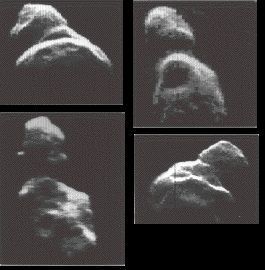Don Savage
Headquarters, Washington, DC November 27, 1996
(Phone: 202/358-1547)
Jane Platt
Jet Propulsion Laboratory, Pasadena, CA
(Phone: 818/354-5011)
RELEASE: 96-249
ODDBALL ASTEROID CAPTURED ON NEW VIDEO COMPUTER SIMULATION
A new computer-generated video visualization is giving
planetary scientists a fresh look at the topsy-turvy rotation
of the intriguing asteroid Toutatis, which is due to pass
near Earth on Nov. 29.

|
Asteroid 4179 Toutatis
November 26, 1996
Image courtesy of
Steve Ostro, JPL
|
Dr. Eric De Jong and animator Shigeru Suzuki of NASA's
Jet Propulsion Laboratory (JPL), Pasadena, CA, combined
several computer simulation and scientific visualization
techniques to show the bizarre rotation and surface details
of Toutatis as it tumbles erratically on its journey around
the Sun. The video includes images of Toutatis from various
vantage points, including the perspective of someone standing
on its surface. In addition, trajectories and explosive
surface impacts are shown for a more typical near-Earth
asteroid, named Castalia.
The animation was created at the JPL Digital Image
Animation Laboratory (DIAL) from a model based on a previous
sequence of delay-Doppler radar images. Those images were
recorded at NASA's Deep Space Network 70-meter and 34-meter
radio/radar antennas in Goldstone, CA, and the 305-meter
Arecibo Radio Telescope in Puerto Rico.
"It's amazing that the shape of Toutatis can be
determined so accurately from ground-based observations," De
Jong said. "This technology will provide us with startling,
close-up views of thousands of asteroids that orbit near the Earth."
Dr. Scott Hudson of Washington State University,
Pullman, WA, collaborated on the venture, along with
scientists at NASA's Ames Research Center, Mountain View, CA.
"We used the computer to mathematically create a three-
dimensional model of the surface and rotation of Toutatis,"
Hudson said. "It's as though we put a clay model in space and
molded it until it matched the appearance of the actual asteroid."
The video is of particular interest as Toutatis nears
Earth and makes its closest approach on Friday, Nov. 29, when
it will pass by at a distance of 3.3 million miles (5.3
million kilometers), or about 14 times the distance from the
Earth to the Moon. In 2004, Toutatis will pass only four
lunar distances from Earth, closer than any known Earth-
approaching object expected to pass by in the next 60 years.
However, "Toutatis poses no significant threat to Earth,
at least for a few hundred years," according to JPL senior
research scientist Dr. Steven Ostro, who observed Toutatis in
1992 and is studying the asteroid once again this week at Goldstone.
Discovered in 1989 and named after a Celtic god, the
asteroid Toutatis has dimensions of 2.9 by 1.5 by 1.2 miles
(4.6 by 2.4 by 1.9 kilometers.) It is considered one of the
strangest bodies in the Solar System, given its peculiar
rotation and odd shape, which resembles two chunks of rock
connected by a narrow neck-like structure. The rocky body's
strange traits are believed to be the result of a history of
violent collisions.
Asteroids, sometimes known as minor planets, are small
orbiting bodies composed of rock and metals. They hold
special fascination for scientists because of their age,
quantity and proximity to the Earth. Scientists estimate that
there are more than 100,000 near-Earth asteroids larger than
a football stadium.
"The discovery that we live in an asteroid swarm is
important for the future of humanity," said Ostro. "These
leftover debris from planetary formation can teach us a good
deal about the formation of our Solar System. Asteroids also
contain valuable minerals and many are the cheapest possible
destinations for space missions."
For example, a flyby of the asteroid McAuliffe is
planned by the first flight mission in NASA's New Millenium
Program, which is designed to test and apply new technologies
for use in future space science and Earth science missions.
New Millennium is managed by JPL for NASA's Offices of Space
Science and Mission to Planet Earth, Washington, DC.
In addition, NASA's Near Earth Asteroid Rendezvous
(NEAR) mission, launched in February 1996, is en route to the
asteroid Eros, which it will orbit beginning in January 1999.
|
|
PUBLIC INFORMATION OFFICE
JET PROPULSION LABORATORY
CALIFORNIA INSTITUTE OF TECHNOLOGY
NATIONAL AERONAUTICS AND SPACE ADMINISTRATION
PASADENA, CALIF. 91109. (818) 354-5011
PHOTO CAPTION (TOP) P-41525
January 4, 1993
Toutatis Radar Images
These are radar images of asteroid 4179 Toutatis made during the
object's recent close approach to Earth on December 8, 1992. The images reveal
two
irregularly shaped, cratered objects about 4 and 2.5 kilometers
(2.5 and 1.6 miles) in average diameter which are probably in
contact with each other. The four frames shown here (from left to
right) were obtained on Dec. 8, 9, 10 and 13 when Toutatis was
an average of about 4 million kilometers (2.5 million miles) from
Earth. The time required to obtain each of these images was 55,
14, 37 and 85 minutes, respectively. On each day, the asteroid
was in a different orientation with respect to Earth. In these
images, the radar illumination comes from the top of the page, so
parts of each component facing toward the bottom are not seen.
The large crater shown in the Dec. 9 image (upper right)

|
Asteroid 4179 Toutatis
December 8-13, 1992
Images courtesy of
Steve Ostro, JPL
|
is about 700 meters (2,300 feet) in diameter. The radar
observations were carried out at the Goldstone Deep Space
Communications Complex in California's Mojave desert by a team
led by Dr. Steven Ostro of JPL. For most of the work, a
400,000-watt coded radio transmission was beamed at Toutatis from
the Goldstone main 70-meter (230-foot) antenna. The echoes,
which took as little as 24 seconds to travel to Toutatis and
back, were received by the new 34-meter (112-foot) antenna and
relayed back to the 70-meter station where they were decoded and
processed into images. The radar observations were part of the
Planetary Astronomy Program of NASA's Office of Space Science and
Applications.
|












